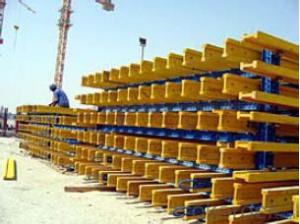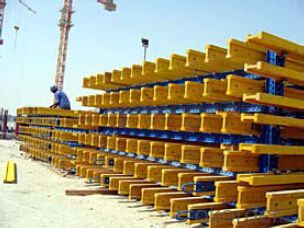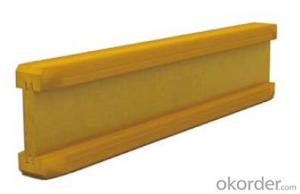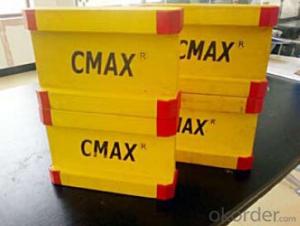Timber-Beam Plywood Formwork for Building Construction
- Loading Port:
- Tianjin
- Payment Terms:
- TT OR LC
- Min Order Qty:
- 50 m²
- Supply Capability:
- 1000 m²/month
OKorder Service Pledge
Quality Product, Order Online Tracking, Timely Delivery
OKorder Financial Service
Credit Rating, Credit Services, Credit Purchasing
You Might Also Like
Plywood --- make perfect concrete surface
WISA-Form Birch is a coated special plywood using in the formwork systems where high
requirements are set on the concrete surface and the times of reuses.
With CNBM timber beam & WISA plywood, the formwork is low weight but high load capacity, it is
widely used in construction.
Characteristics:
◆ Component with high standardization.
◆ Assembling in site, flexible application.
◆ Light weight, easy transportation and storage.

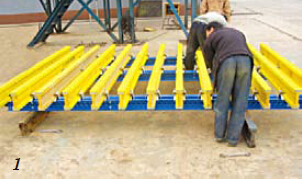
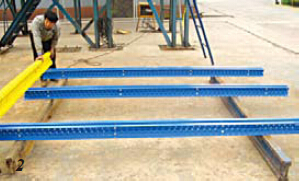
- Q: What are the common types of connections used in steel formwork systems?
- The common types of connections used in steel formwork systems include: 1. Wedge connections: This type of connection involves using a wedge-shaped device to secure the panels together. The wedge is inserted into a slot and tightened, creating a reliable and strong connection. 2. Pin and wedge connections: This connection method involves using pins and wedges to connect the formwork panels. The pins are inserted through holes in the panels, and the wedges are then driven into the pins to lock them in place. 3. Bolted connections: Bolts are used to connect the formwork panels together. Holes are pre-drilled in the panels, and bolts are inserted through these holes and tightened with nuts. This type of connection allows for easy disassembly and reassembly of the formwork system. 4. Clamped connections: Clamps are used to connect the formwork panels. These clamps are typically made of steel and are tightened using bolts or screws. This type of connection provides a secure and rigid joint between the panels. 5. Magnetic connections: Magnetic connections use magnets to connect the formwork panels. Magnetic strips or plates are embedded in the panels, and when the panels are brought close together, the magnets attract and hold them in place. This type of connection is quick and easy to use, but it may not be as strong as other connection methods. These different types of connections offer various advantages and disadvantages, and the choice of connection method depends on factors such as the specific project requirements, ease of assembly, disassembly, and the desired strength and stability of the formwork system.
- Q: What are the common design considerations for steel formwork in high-rise construction?
- High-rise construction necessitates careful evaluation of several design considerations for steel formwork. First and foremost, it is crucial to assess the load-bearing capacity of the formwork. Heavy loads, including concrete weight, equipment, and workers, are common in high-rise constructions. Thus, the steel formwork must be designed to withstand these loads and prioritize construction safety. Durability and longevity are also key factors to consider. High-rise construction projects often span months or even years, necessitating formwork that can endure prolonged use and exposure to diverse weather conditions. Steel formwork is preferred for its strength and resistance to wear and tear. Additionally, the formwork design should prioritize ease of assembly and disassembly. Frequent repositioning of the formwork during the building process is common in high-rise construction projects. Consequently, the formwork system should enable efficient and swift assembly and disassembly, minimizing downtime and boosting productivity. Flexibility and adaptability are crucial in the formwork design for high-rise construction. The formwork must be capable of accommodating various shapes and sizes of concrete elements, such as columns, walls, and slabs. This necessitates a well-designed formwork system that can be easily adjusted and modified to meet specific requirements in each construction phase. Safety is of paramount importance in high-rise construction. The formwork design should incorporate appropriate safety features, such as handrails, guardrails, and non-slip surfaces, to prevent accidents and ensure worker well-being. Lastly, cost-effectiveness is a significant consideration. High-rise construction projects can be financially demanding, and the formwork design should aim to minimize material and labor costs without compromising quality and safety. In conclusion, the design considerations for steel formwork in high-rise construction encompass load-bearing capacity, durability, ease of assembly and disassembly, flexibility, safety, and cost-effectiveness. By addressing these factors, engineers and designers can ensure successful and efficient execution of high-rise construction projects.
- Q: How does steel formwork affect the overall long-term performance of the structure?
- The overall long-term performance of a structure can be significantly influenced by the use of steel formwork. One of the main advantages of steel formwork is its durability, as steel is a robust and resilient material that can endure heavy loads and extreme weather conditions, thereby ensuring the structure's longevity. The utilization of steel formwork provides a rigid and stable framework for pouring concrete. This, in turn, leads to a more precise and accurate construction process, ultimately resulting in a stronger and higher quality structure. Moreover, steel formwork allows for quicker construction as it can be easily assembled and disassembled, reducing the overall construction time. Additionally, steel formwork offers a smooth and flat surface finish, which is vital for the aesthetic appeal of the structure. The smooth surface reduces the need for additional finishing work, saving both time and money. Furthermore, the use of steel formwork guarantees proper support and reinforcement for the concrete, preventing issues such as cracking, sagging, or deformation over time. Another advantage of steel formwork is its reusability. Unlike traditional wooden formwork, steel formwork can be used multiple times, resulting in cost savings and a reduced environmental impact. The durability and strength of steel formwork enable it to endure the wear and tear of multiple uses, making it a more sustainable option. To summarize, steel formwork has a positive impact on the overall long-term performance of a structure by providing durability, strength, accuracy, and reusability. It ensures a construction process of high quality, resulting in a robust and aesthetically pleasing structure that can withstand the test of time.
- Q: What are the different types of formwork accessories used with steel formwork?
- Steel formwork commonly utilizes various types of formwork accessories to enhance functionality, efficiency, and worker safety during construction. 1. Formwork clamps securely fasten formwork panels together, ensuring their stability and preventing movement during concrete pouring. They come in different sizes and designs to accommodate various formwork systems. 2. Formwork props are adjustable steel supports used to provide vertical stability and load-bearing capacity to formwork panels. This ensures worker safety while operating on the system. 3. Formwork ties firmly hold formwork panels in place, preventing bulging or deflection under the weight of concrete. Made of steel, they are available in different lengths and designs to meet project requirements. 4. Formwork connectors join formwork panels at corners or joints, ensuring a tight and secure fit. They come in various shapes and sizes, including corner connectors, wedge connectors, and pin connectors. 5. Formwork brackets support formwork panels horizontally, providing additional stability and reinforcement. They are commonly used in beam and slab construction to support formwork across long spans. 6. Formwork release agents are chemical substances applied to the formwork surface to prevent concrete adhesion. This allows for easy removal of the formwork after concrete curing, facilitating efficient and smooth formwork removal. In conclusion, these formwork accessories are vital for the success of a steel formwork system, providing the necessary support, stability, and reinforcement for efficient and safe construction of concrete structures.
- Q: How does steel formwork accommodate for different concrete pouring heights?
- Steel formwork can accommodate for different concrete pouring heights by being adjustable and customizable. The formwork panels can be easily adjusted or cut to the required height, allowing for flexibility in creating various concrete pouring levels. Additionally, steel formwork systems often include adjustable accessories such as props or telescopic beams that can be extended or retracted to match the desired pouring height. This adaptability ensures that the steel formwork can effectively accommodate different concrete pouring heights during construction projects.
- Q: How does steel formwork handle complex geometries?
- Steel formwork is able to handle complex geometries due to its inherent strength and flexibility. The steel panels can be easily cut and shaped to fit intricate designs, allowing for the creation of complex shapes and curves. Additionally, steel formwork can be assembled and disassembled, making it highly adaptable to different geometries and construction requirements. The rigidity and stability of steel also ensure that the formwork maintains its shape during concrete pouring, resulting in precise and accurate structures. Overall, steel formwork offers the versatility and durability needed to effectively handle complex geometries in construction projects.
- Q: What are the different types of form release agents used with steel formwork?
- There are several types of form release agents used with steel formwork, including petroleum-based, water-based, and emulsion release agents. Petroleum-based release agents are commonly used and provide good release properties, but they may have environmental concerns. Water-based release agents are environmentally friendly and provide a good release, but they may require additional drying time. Emulsion release agents are a combination of oil and water and offer a balance between petroleum-based and water-based agents. The choice of form release agent depends on factors such as the desired release properties, environmental considerations, and specific project requirements.
- Q: Can steel formwork be used for staircase construction?
- Indeed, steel formwork is perfectly suitable for the construction of staircases. This versatile and resilient material is frequently employed in construction ventures, including staircase construction. It furnishes a robust and secure framework for pouring concrete and guarantees the meticulous and precise formation of the staircase. Moreover, steel formwork can be reused, rendering it a cost-effective option for repetitive construction procedures such as staircase construction. Furthermore, it offers adaptability in terms of design, enabling the creation of diverse staircase shapes and dimensions. In summary, steel formwork is an ideal selection for staircase construction due to its potency, durability, reusability, and design flexibility.
- Q: Does steel formwork require any special expertise or training for installation?
- Installation of steel formwork necessitates specialized expertise and training. Steel formwork comprises intricate interlocking panels and components that serve as temporary molds for pouring concrete structures. It demands a comprehensive grasp of formwork design, installation techniques, and safety protocols. Professionals who engage in steel formwork must possess in-depth knowledge of project-specific prerequisites, including load-bearing capacity, formwork connections, and appropriate reinforcement placement. They must also be capable of accurately measuring and cutting steel panels, assembling them correctly, and ensuring proper alignment and bracing of the formwork. Additionally, proficiency in steel formwork installation entails familiarity with various formwork systems, such as adjustable steel formwork, modular steel formwork, or tunnel formwork. Selecting the most suitable system for a given project is paramount. This knowledge is critical to guarantee that the formwork can endure the pressure exerted by wet concrete and yield a structurally sound and visually appealing end result. Furthermore, comprehensive training in steel formwork installation is indispensable to ensure the safety of workers and the overall success of the construction endeavor. This encompasses understanding safety regulations, employing personal protective equipment effectively, and being mindful of potential hazards and their mitigation methods. In conclusion, given the intricate nature and specific requisites of steel formwork installation, it is imperative to enlist professionals possessing the requisite expertise and training to facilitate a streamlined and prosperous construction process.
- Q: What are the advantages of using steel formwork?
- Construction projects can benefit from the use of steel formwork for several reasons. Firstly, steel formwork is known for its durability and longer lifespan compared to materials like timber or plywood. This results in cost savings as it can be reused multiple times. Additionally, steel formwork is resistant to warping, shrinking, or expanding due to changes in humidity or temperature, ensuring accurate and consistent results during construction. Secondly, steel formwork provides excellent strength and stability, making it ideal for constructing large or complex structures. Its rigidity minimizes the risk of deformations and guarantees the structural integrity of the concrete. As a result, the finished product is of high quality. Furthermore, steel formwork offers a smooth and consistent surface finish, which is particularly advantageous for architectural projects where aesthetics are crucial. The steel surface prevents leakage, reducing the need for additional waterproofing measures and minimizing the risk of defects or cracks in the concrete. Moreover, steel formwork is highly adaptable and easily customizable to fit various shapes and sizes. This flexibility allows for the construction of unique and complex designs, providing architects and engineers with more freedom in their creative process. Lastly, steel formwork is time-efficient. Its modular nature and ease of assembly and dismantling facilitate faster construction cycles, ultimately reducing project timelines. This quick turnaround time translates into cost savings and increased productivity on the construction site. In conclusion, steel formwork offers numerous advantages in construction projects, including durability, strength, a smooth surface finish, adaptability, and time-efficiency. These benefits make it a preferred choice, enhancing construction quality, reducing costs, and improving overall efficiency.
Send your message to us
Timber-Beam Plywood Formwork for Building Construction
- Loading Port:
- Tianjin
- Payment Terms:
- TT OR LC
- Min Order Qty:
- 50 m²
- Supply Capability:
- 1000 m²/month
OKorder Service Pledge
Quality Product, Order Online Tracking, Timely Delivery
OKorder Financial Service
Credit Rating, Credit Services, Credit Purchasing
Similar products
Hot products
Hot Searches
Related keywords

